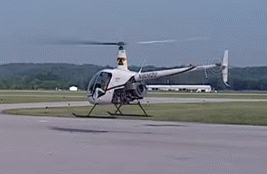 "Chris Clarke" (shiftsandgiggles)
"Chris Clarke" (shiftsandgiggles)
08/08/2013 at 16:43 • Filed to: helicopnik
 1
1
 9
9
 "Chris Clarke" (shiftsandgiggles)
"Chris Clarke" (shiftsandgiggles)
08/08/2013 at 16:43 • Filed to: helicopnik |  1 1
|  9 9 |

If you want to go for a fun ride, have your instructor simulate and anti torque failure while in hover.
This is me riding along by the way. I also have video of this, but linking to youtube overrides the gif which is quite entertaining to me.
 ZeroOrDie - Powered By MZR
> Chris Clarke
ZeroOrDie - Powered By MZR
> Chris Clarke
08/08/2013 at 17:17 |
|
I'm assuming the whole thing starts spinning the same way as the blades?
 TheLateApex
> Chris Clarke
TheLateApex
> Chris Clarke
08/08/2013 at 17:24 |
|
#helisarebad ?
j/k
 BoxerFanatic, troublesome iconoclast.
> ZeroOrDie - Powered By MZR
BoxerFanatic, troublesome iconoclast.
> ZeroOrDie - Powered By MZR
08/08/2013 at 17:47 |
|
The opposite direction of the blades. engine torque tries to equalize the spin rate between the rotor head and the airframe, in opposite directions.
Anti-torque failure basically means that the tail rotor has failed for some reason, and the tail rotor isn't pushing back against, and canceling out the engine's torque on the airframe.
 ZeroOrDie - Powered By MZR
> BoxerFanatic, troublesome iconoclast.
ZeroOrDie - Powered By MZR
> BoxerFanatic, troublesome iconoclast.
08/08/2013 at 17:49 |
|
That's better. Got about half of that!
 The WB
> Chris Clarke
The WB
> Chris Clarke
08/08/2013 at 18:17 |
|
Easy peasy, just turn off the engine, presto. No more torque. Then you'll have a nice few seconds to relax and pat yourself on the back before crashing into the ground at terminal velocity.
 Chris Clarke
> The WB
Chris Clarke
> The WB
08/08/2013 at 19:05 |
|
That's basically the recovery procedure. At hover, you just lower the collective, which essentially takes the torque away from the main rotors, but you go right down. In cruise flight, an anti-torque failure just means you fly sideways a little and you would just do an emergency run-on landing to keep from spinning out of control.
 Chris Clarke
> TheLateApex
Chris Clarke
> TheLateApex
08/08/2013 at 19:06 |
|
#athousandmovingpartsalltryingtokillyou
 BoxerFanatic, troublesome iconoclast.
> ZeroOrDie - Powered By MZR
BoxerFanatic, troublesome iconoclast.
> ZeroOrDie - Powered By MZR
08/08/2013 at 19:20 |
|
It is due to newtons law... equal and opposite reaction, and all that.
applying torque to the rotors to get them to spin one direction, results in an opposite force that tries to spin the rest of the helicopter in the other direction.
It gets complex with air resistance, and mass differentials, and such... but that is basically the gist.
The tail rotor of a helicopter exists to push air sideways and add another opposite force to the main body of the helicopter, to cancel out the reaction torque, and 'neutralize' the rotation of the helicopter's body, leaving only the rotation of the rotors.
Adding more tail rotor effect than engine torque causes the helicopter to yaw the same direction as the main rotor rotation. subtracting some tail rotor effect allows engine torque to overcome the tail rotor, and yaw the helicopter opposite to the main rotor rotation, sort of a plus or minus from that neutral state.
That tail rotor control is usually done by the foot pedals.
If the tail rotor or is damaged, or otherwise mechanically fails, the engine torque on the body of the helicopter is un-checked, and the whole vehicle spins uncontrollably, and usually crashes unless control is quickly restored, and the body spin can be neutralized again.
That is one of the reasons that helicopter pilots are usually a different kind of person than most fixed-wing pilots... careful to the point of paranoia, because one mechanical failure can bring the whole thing down... Helicopters don't glide... so chopper pilots have a reputation for being hyper-sensitive to noises and little actions and details that their helicopters make.
 ZeroOrDie - Powered By MZR
> BoxerFanatic, troublesome iconoclast.
ZeroOrDie - Powered By MZR
> BoxerFanatic, troublesome iconoclast.
08/09/2013 at 09:12 |
|
So they are the squids of the aviation world.